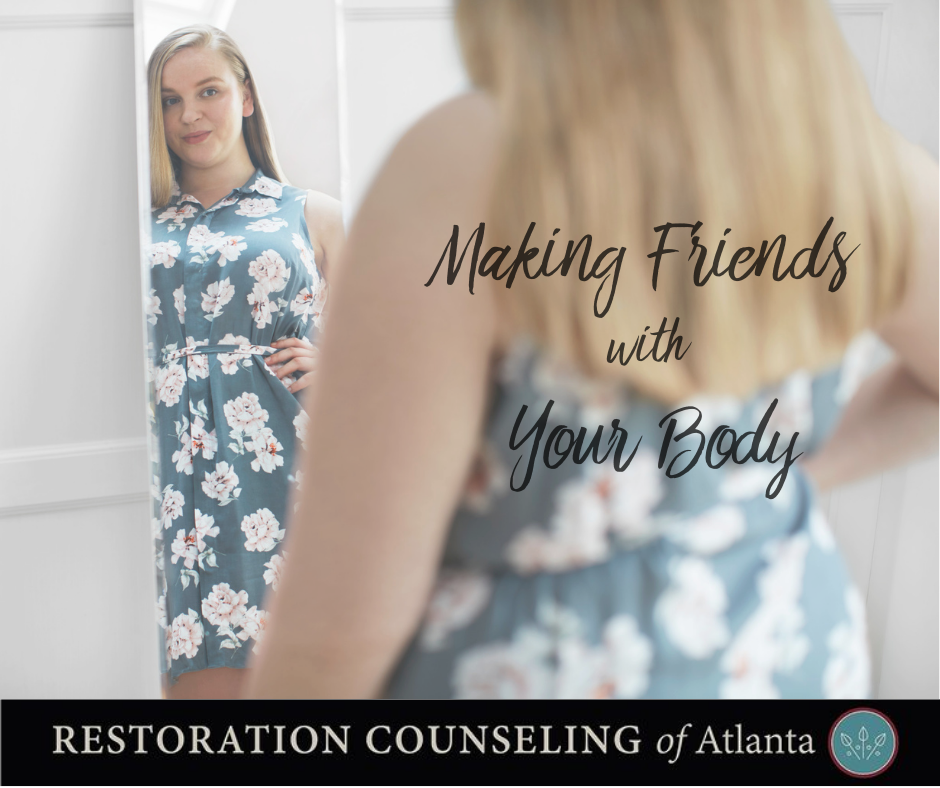If you were asked to use three words to describe your relationship with your body, what would you say? While our answers would be different, my guess is we’d find common ground in words like difficult, disconnected, neutral, confusing, and even painful. Some of us may have never even thought about this question before. The truth is, whether we realize it or not, many of us have complicated relationships with our bodies.
Research suggests that 80-85% of women are unsatisfied with their bodies, while around 30% of men struggle with body shame. Most reports claim that body dissatisfaction begins at an early age and persists throughout the duration of our lives. Take that in. That’s likely more than half of the people you know struggling for most of their lives with body shame. This is a pervasive, systemic, generational issue. One that leaves many of us feeling defeated as we attempt to find a cure. So, what’s the disconnect? Why is body shame so pervasive?
Defining Body Shame
Let’s start with a definition of body shame. Body shame is the process of criticizing ourselves or others for perceived bodily flaws. It develops over time through reinforced messages, whether external or internal, about what our bodies should be and how they are not measuring up. Can you recall comments from people in your life that labeled bodies as “good” or “bad”? Can you remember times when a family member shared that they needed to lose weight? Although some comments are well-meaning, we are flooded with both covert and overt messages that impact how we see our own bodies over time. The media and diet culture also inundates us with messages that shape the larger culture’s “standard” of an ideal body. Our brains internalize each of these messages and build storylines upon them. Because our bodies are a central part of who we are, these narratives begin to shape not only how we see our bodies, but also our sense of identity.
The Problem with Our Solutions
For many of us, we attempt to cure body shame by either changing the appearance of our body or ignoring the body altogether.
On one end of that continuum, we become obsessed with “fixing” our body. We tell ourselves that it is the problem, and if it could only change, we would feel differently about it. This solution typically leads to disordered eating behaviors such as restricting, overexercising, and more. Not only does it miss the underlying roots, it also isn’t effective. Once we begin to think negatively about our bodies, our brains are going to look for evidence that this is true over and over. This is called “distorted thinking.” This type of thinking pattern prevents us from seeing ourselves clearly, no matter what our body “looks” like.
At the other end of the continuum, we begin to dismiss our bodies altogether. In an attempt to numb the shame we experience, we disregard our bodies as a valuable part of our being. We cover them up, we avoid looking at them as we pass a mirror, and we start tuning out their cues and signals. Some of us might have learned to fix body shame by “forgetting” about our bodies and focusing instead on internal qualities. The problem with this solution is that it misses a key part of the healing process: involving our bodies. When we dismiss our bodies as a key part of our lives, we are accomplices to shame’s mission.
Ultimately, both of these solutions fall short because we cannot heal from shame through attempts to change or ignore ourselves. Shame is the one asking us to do that. Instead, we begin the work of healing from shame through connection.
The Process of Connecting to Our Bodies
In The Body Keeps the Score, Dr. Bessel van der Kolk says that “our sense of ourselves is anchored in a vital connection with our bodies.”
When we disconnect from our bodies, we also disconnect from ourselves. But it is very difficult to be connected to something that triggers painful emotions. That is why our attempts often leave us where we started. When we are hurt in a relationship with someone, it takes time to rebuild trust and connect safely. The same is true for our relationship with our bodies. The work of healing is slow, but it starts with getting to know our bodies again and reconnecting to them in safe ways. Instead of attempting to change our body or change how we think about it, we start by turning towards our bodies and listening to them again. By doing so, we are inviting the body back into its own story. Here are a few ways to start this process:
1. Engage your senses.
One of the simplest and most powerful ways that we connect to our bodies is by utilizing our senses. You probably learned about your sense organs at an early age, but when is the last time you consciously thought about them? Our five basic senses – sight, touch, hearing, smell, and taste – allow us to interact with, perceive, and experience the world around us. When we take in information through our senses, we are more present to ourselves and our lived experiences. In doing so, we reclaim the body’s essential role in being alive. And the good news is that we can do this anytime, anywhere. To try it, go outside and spend a few moments noticing what it feels when the wind touches your face, any smells you notice, and the different colors you see before your eyes. Light a candle and take in the scent. Slow down when you take your next bite and notice each of the flavors in your mouth. Each of these practices are key in recognizing our body’s place in our lives.
2. Listen to your body’s cues.
Our bodies are speaking to us all of the time. They tell us when we are hot and cold, hungry and full, uncomfortable, in pain, exhausted, relaxed, and so much more. When was the last time that you slowed down and really became curious about what your body is telling you? This is not a comfortable process, especially if we have survived body shame by ignoring those very cues. One place to start is to spend five minutes a day checking in with your bodily sensations. You can do this by sitting in a comfortable position and scanning your body from head to toe, then noticing any signal your body is sending. Notice if you feel any tension in your shoulders, heaviness in your chest, butterflies in your stomach, or more. You can also regularly pause throughout the day and ask yourself, “Am I hungry?” “Am I tired?” “Am I tense?” Then spend a few moments noticing what your body is signaling.
3. Begin meeting your body’s needs.
Once you’ve begun tuning into your body, an action step to rebuilding trust is choosing to give your body what it needs. This step is not as easy as it sounds. Let’s say you’ve tuned in to your body this week and notice that it is constantly tired. However, you are gearing up for a busy week with no intention of stopping. Meeting your body’s needs may require shifting priorities to create space for rest, and not just one time, but over and over. Meeting our body’s needs also means feeding our bodies when we have hunger cues, and honoring fullness cues when our body says it is done. This takes a lot of practice, especially if we have tuned out those cues in the past. When we do this, we are telling our body, “I see you; I hear you; I am willing to listen to you and meet your needs.”
4. Make space for grieving, and honoring your body’s story.
Our bodies have been with us since day one. At all times, in all seasons, and in all experiences, our bodies are with us for the long haul. One way to reconnect to our bodies is to notice the ways our body carries us through life. The complexity of our bodily experiences invites both grief and gratitude. Our body’s story involves all of the beautiful and hurtful experiences of life: chronic pain, infertility, birth, trauma, intimacy, disability, aging, postpartum, movement, and more. We can grieve the ways our body might have let us down, the ways it keeps changing, the ways it hasn’t always been able to protect us from hurt. We can also thank our body for the experiences it endures, for its capabilities and limits, for the ways it changes as we change. In this way, we are building compassion for our bodies as we would a friend.
Hope for Healing
Healing from body shame is slow and takes difficult work. As you start to gain freedom in this area of your life, you can still experience setbacks, difficult days, and painful messages that reinforce the body-shaming voice. But I believe that as we start to make friends with our bodies in our everyday experiences, we begin to view them differently too. As we get to know them again, we make room for more healing in their story. What would it look like for you to connect to your body in a new way?

Written by Haley DePrato

